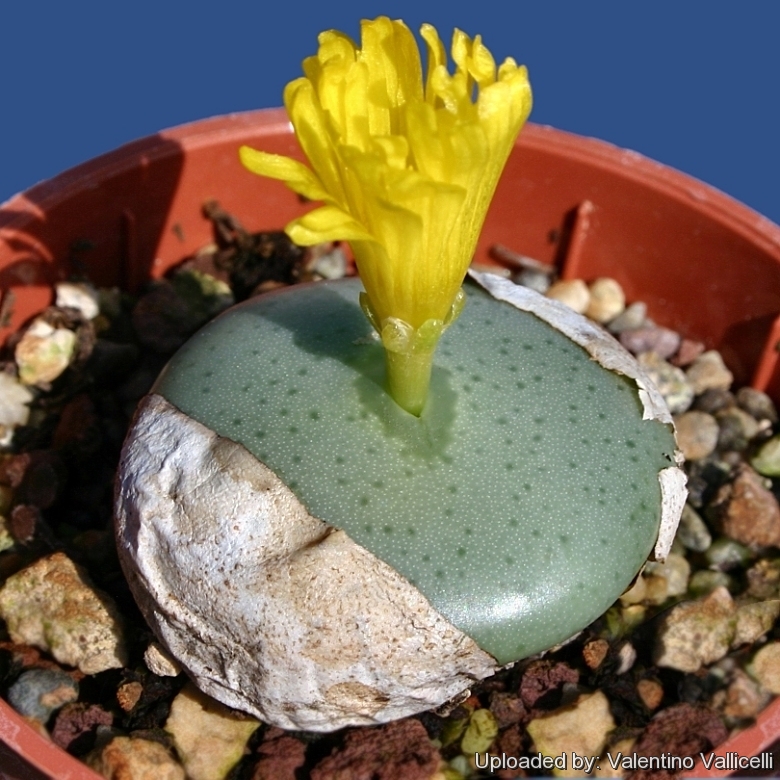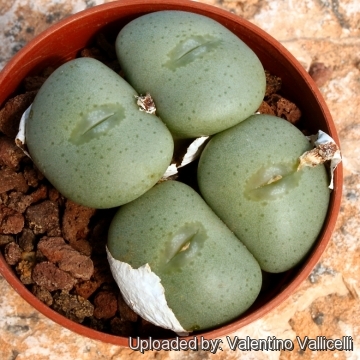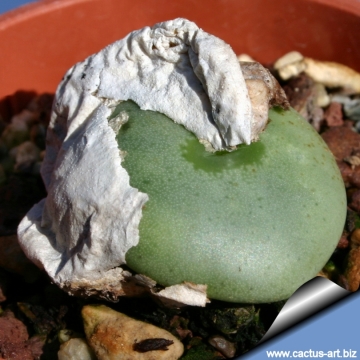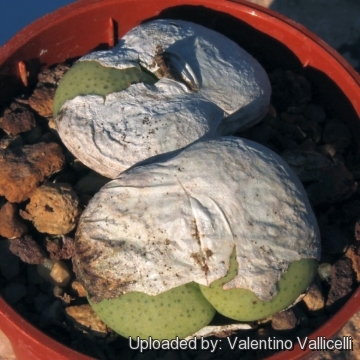
Conophytum flavum Photo by: Valentino Vallicelli
SB1192 Kosies, Steinkopf, Little Namaqualand, North-West Cape Province, South Africa
Origin and Habitat: Little Namaqualand, South Africa
Habitat: Grows on quartz, shale or granite outcrops, often in the crevices of the rock .
Synonyms:
See all synonyms of Conophytum flavum
Common Names include:
RUSSIAN (Русский): Конофитум желто-оранжевый
Description: C. flavum is a tiny bluish green succulent plant with golden yellow flowers, these plants are variably caespitose, with single or double bodies, or forming dense mats or cushions. This species is often difficult to distinguish from Conophytum wettsteiniiSN|21939]]SN|21939]] which is indeed a different diploid species with far smoother epidermis and violet blooms.
Bodies (paired leaves): Large, flat, obconic, circular or elliptic in outline viewed from above, usually larger than 15 mm and up to 3.5 cm in diameter truncate, slightly depressed or concave at top, surface smooth, glabrous, light grey-green, bluish-green or whitish-green with some (usually not very numerous) or without darker green spots scattered over the top. It has a small growing cleft that doesn't reach right across the body. In spring the colour of the old leaves fades, and they shrivel to a thin dry sheath that protects next season's growth during the summer resting phase.
Flowers: Large, 20-25 mm in diameter, daisy-like, yellow pale yellowish and not scented. Petals about 55 in about 2 series, thin, forming an almost star-like, spidery structure. Tube about long as the entire calyx, stamens about as many as the petals, in 2-3 series, all collected together at the mouth of the corolla tube and more or less exserted from it; filaments yellow at the upper part; anthers of the same yellow as the petals. Style 4 mm long nearly as long the stamens, slender, with 4 minute stigmas at the top, yellowish at the upper part, greenish below.
Blooming season: The flowers open in the morning in bright sunshine, closing at the latter part of the afternoon. Blooms mostly August trough November.
Fruits: 4-7 locular. Smooth pale brown.
Subspecies, varieties, forms and cultivars of plants belonging to the Conophytum flavum group
Bibliography: Major references and further lectures
1) Gibbs Russell, G. E., W. G. Welman, E. Reitief, K. L. Immelman, G. Germishuizen, B. J. Pienaar, M. v. Wyk & A. Nicholas. 1987. “List of species of southern African plants.” in: Mem. Bot. Surv. S. Africa 2(1–2): 1–152(pt. 1), 1–270(pt. 2).
2) James Cullen, Sabina G. Knees, H. Suzanne Cubey “The European Garden Flora Flowering Plants: A Manual for the Identification of Plants Cultivated in Europe, Both Out-of-Doors” Cambridge University Press, 11/Aug./2011
3) Hammer, S. 1993. “The Genus Conophytum - A Conograph.” Succulent Plant Publications, Pretoria.
4) Hammer, S. 2002. “Dumpling and His Wife: New Views of the Genus Conophytum.” East Anglia Engraving Creative Colour Ltd, Norwich, England.
5) Ernst Van Jaarsveld, Ben-Erik Van Wyk, Gideon Smith “Succulents of South Africa: A Guide to the Regional Diversity” Tafelberg Publishers, Limited, 01/lug/2000
6) Heidrun E.K. Hartmann “Illustrated Handbook of Succulent Plants: Aizoaceae A-E” Springer, 2002
7) Werner Rauh “The Wonderful World of Succulents: Cultivation and Description of Selected Succulent Plants Other Than Cacti” Smithsonian Institution Press, 1984
8) Matlamela, P.F. & Kamundi, D.A. 2006. Conophytum flavum N.E.Br. subsp. flavum. National Assessment: "Red List of South African Plants" version 2013.1. Accessed on 2014/02/04
 Conophytum flavum Photo by: Valentino Vallicelli
Conophytum flavum Photo by: Valentino Vallicelli SB1192 Kosies, Steinkopf, Little Namaqualand, North-West Cape Province, South Africa Photo by: Valentino Vallicelli
SB1192 Kosies, Steinkopf, Little Namaqualand, North-West Cape Province, South Africa Photo by: Valentino Vallicelli Conophytum flavum Photo by: Cactus Art
Conophytum flavum Photo by: Cactus Art Conophytum flavum Photo by: Valentino Vallicelli
Conophytum flavum Photo by: Valentino VallicelliCultivation and Propagation: C. flavum is easy to grow. These plants grow on winter rain and head for summer dormancy. More or less dormant in summer. The plant requires little water; otherwise its epidermis breaks (resulting in unsightly scars). Water throughout the year although minimally in summer, (only when the plant starts shrivelling), but it will generally grow even in summer if given water. Water regularly in winter after the previous year's leaves have dried up. Requires good drainage. Keep cool and shaded from hot sun in mid-summer; it needs full sun or light shade in the other seasons. Hardy to -2°C. Ensure a very good ventilation. Avoid to repot frequently. This plant may stay in the same pot for many years. Plants grown in larger containers have frequently relatively poor flowers. It might improve when the plants are given their own, small individual pots.
Propagation: It can be reproduced both by cuttings and seeds. Take the cutting from a grown-up mother plant. Each cutting must contain one or more heads, along with a fraction of root.















